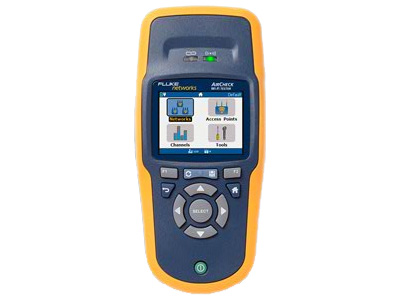Fluke Networks AirCheck Wi-Fi Tester

The AirCheck Wi-Fi Tester from Fluke Networks, announced today, is a convenient tool for network managers and technicians to troubleshoot wireless issues. All too often, Wi-Fi testing is carried out in a Heath Robinson manner using freeware/shareware tools installed on a laptop, which is a cumbersome way to operate.
Aimed at businesses of all sizes, Fluke's AirCheck Wi-Fi Tester costs £1,796 and will be available in the second quarter. An add-on directional antenna — useful for locating particular access points — will cost £175 extra.

Fluke's AirCheck Wi-Fi Tester costs £1,796 and runs for up to 5.5 hours on a single battery charge.
The AirCheck is a chunky bit of yellow-and-blue/grey handheld kit, measuring 8.9cm wide by 19.8cm deep by 4.8cm thick and weighing 400g with its removable 18.5Wh lithium-ion battery pack. It has a 2.8in. colour display (non-touch, 320 by 240 pixels) and a keypad with four directional buttons, a select button, Home and Back buttons, two function keys and a rocker button with 'restart all tests' on the left and 'save session reports' on the right.
To download session information, the AirCheck connects via a Mini-USB port to a (Windows XP, Vista or 7) PC running Fluke's AirCheck Manager software, which lets you manage profiles and create reports. You can't recharge the device over USB though: for that, you get a 15V AC adapter with a round-pin barrel connector. Battery life is quoted at 5.5 hours, with a 3h charge time.
Hit the green power button beneath the keypad and the AirCheck boots up in about three seconds and starts searching for Wi-Fi networks, access points and channels — it covers 802.11a/b/g/n in both 2.4GHz and 5GHz frequency bands. There are four big buttons on the home screen (Networks, Access Points, Channels and Tools), and you'll probably be tempted to tap them. Unfortunately this is not a touchscreen, so you'll have to make do with the keypad.
If a 'rogue' Wi-Fi network or access point appears in your vicinity, AirCheck will find it and let you investigate its properties. Here, it has found a Mi-Fi device (SSID: IMHS_2352_9B95).
Select Networks and you get a list of visible wireless LANs with signal level, security, SSID name, network type (a,b,g and/or n). From there you can drill down to see the access points (APs), get detail on particular APs, locate an AP — perhaps a rogue one — by graphing its signal strength and following an audio indicator, and connect to an AP to test its performance.
Wi-Fi traffic (blue) and interference (grey — in the top image mostly from a nearby microwave) on the same 802.11g channel in different locations.
The Access Points button lists all the visible APs and lets you mark them as authorised, unauthorised, neighbour, guest or flagged for easy future reference. Channels takes you to a display of 2.4GHz and 5GHz Wi-Fi channels, and shows Wi-Fi traffic in blue and interference (from a nearby microwave, for example) in grey. However, it's not always clear how the device differentiates between Wi-Fi and interference, as sometimes a lot of 'interference' was associated with heavy network traffic. Also, the unit sometimes reported considerable Wi-Fi traffic on channels where no access point was listed.
Under Tools, the most intriguing function is List Probing Clients: this discovers client devices that are seeking a Wi-Fi connection, and we noticed that the drill-down screen also sometimes reports SSID names to which the client has previously connected.
We had a pre-production sample of the AirCheck Wi-Fi Tester, and although we didn't notice any hardware problems, the AirCheck Manager software was distinctly crash-prone. However, by the time it ships, any glitches should have been ironed out, making this a useful — if pricey — weapon in the network manager's arsenal.